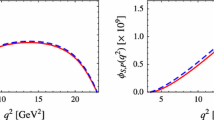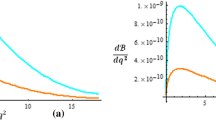Abstract
The decay modes of B meson consisting tau leptons as final state particle are seemed to be the key feature for searching new physics. As the experimental measurements for b → sτ+τ− processes are still not confirmed, the theoretical study of these decays is playing vital role in recent times. The lepton flavor universality violation gains much curiosity after the observation of RK and \( {R}_{K^{\ast }} \) anomalies in semileptonic \( B\to \left(K,{K}^{\ast}\right)\mu \overline{\mu} \) channel which provides a hint towards μ − e non-universality in flavor sector. In this paper, we have devoted our concern to the decay mode B → (K, K∗)τ+τ− to predict the branching ratio. We have also searched for the τ − l (where l = e, μ) lepton flavor non-universality for neutral current transitions. We have estimated our results in the standard model as well as in Z′ model.


Similar content being viewed by others
References
Melikhov, D., Nikitin, N., Simula, S.: Lepton asymmetries in exclusive b → sl+l− decays as a test of the standard model. Phys. Lett. B. 430, 332 (1998) arXiv: hep-ph/9803343
Aaij, R., (LHCb Collaboration), et al.: Measurement of form-factor-independent observables in the B0→K*0 μ+μ- decay. Phys. Rev. Lett. 111, 191801 (2013) arXiv: 1308.1707
Aaij, R., (LHCb Collaboration), et al.: Test of Lepton Universality using B+ → K+l+l−decays. Phys. Rev. Lett. 113, 151601 (2014) arXiv: 1406.6482
Aaij, R., (LHCb Collaboration), et al.: Test of lepton universality with B0 → K∗0l+l−decays. J. High Energ. Phys. 08, 055, (2017) arXiv: 1705.05802
Alok, A.K., et al.: New physics solutions for RD and RD. J. High Energy Phys. 09, 152 (2018) arXiv: 1710.04127
Bobeth, C., Haisch, U.: New physics in \( {\Gamma}_{12}^{\mathrm{s}}:\left(\overline{\mathrm{s}}\mathrm{b}\right)\left(\overline{\uptau}\uptau \right) \) operators. Acta Phys. Polon. B. 44, 127 (2013) arXiv: 1109.1826
Capdevila, B., et al.: Searching for new physics with b → sτ+τ− processes. Phys. Rev. Lett. 120, 181802 (2018)
Bobeth, C., Haisch, U., Lenz, A., Pecjak, B., Tetlalmatzi-Xolocotzi, G.: On new physics in ΔΓd. J. High Energy Phys. 06, 040 (2014) arXiv: 1404.2531
Alonso, R., Grinstein, B., Camalich, J.M.: Lepton universality violation and lepton flavor conservation in B-meson decays. J. High Energ. Phys. 10, 184 (2015) arXiv: 1505.05164
Crivellin, A., Mueller, D., Ota, T.: Simultaneous explanation of R(D(∗)) and b → sμ+μ−: the last scalar leptoquarks standing. J. High Energy Phys. 09, 040 (2017) arXiv: 1703.09226
Calibbi, L., Crivellin, A., Li, T.: A model of vector leptoquarks in view of the B-physics anomalies. Phys. Rev. D. 98(115), 002 (2018) arXiv: 1709.00692
Aaij, R., (LHCb Collaboration), et al.: Search for the decays \( {B}_s^o\to {\tau}^{+}{\tau}^{-} \) and B 0 → τ + τ −. Phys. Rev. Lett. 118, 251802 (2017) arXiv: 1703.02508
Lees, J.P., (BaBar collaboration), et al.: Search for B+ → K+τ+τ− at the BaBar experiment. Phys. Rev. Lett. 118, 031802 (2017) arXiv: 1605.09637
Bobeth, C., et al.: Bs,d→1+1- in the standard model with reduced theoretical uncertainty. Phys. Rev. Lett. 112, 101801 (2014) arXiv: 1311.0903
Bobeth, C.: Updated \( {\mathrm{B}}_{\mathrm{q}}\to \overline{\ell}\ell \) in the standard model at higher orders. arXiv: 1405.4907, 2014
Kamenik, J.F., Monteil, S., Semkiv, A., Silva, L.V.: Lepton polarization asymmetries in rare semi-tauonic b→s exclusive decays at FCC-ee. Eur. Phys. J. C. 77, 701 (2017) arXiv: 1705.11106
Hewett, J.L.: Tau polarization asymmetry in B → X s τ + τ −. Phys. Rev. D. 53, 4964 (1996) arXiv: hep-ph/9506289
Bouchard, C., et al.: Standard Model predictions for B → Kll with form factors from lattice QCD. Phys. Rev. Lett. 111, 162002 (2013) Erratum: Phys. Rev. Lett. 112, 149902 (2014)], arXiv: 1306.0434
Guetta, D., Nardi, E.: Searching for new physics in rare B → τ decays. Phys. Rev. D. 58, 012001 (1998) arXiv: hep-ph/9707371
Grinstein, B., Savage, M.J., Wise, M.B.: B → Xse+e− in the six-quark model. Nucl. Phys. B. 319, 271 (1989)
Buchalla, G., Buras, A.J., Lautenbacher, M.E.: Weak decays beyond leading logarithms. Rev. Mod. Phys. 68, 1125 (1996) arXiv: hep-ph/9512380
Buras, A.J., Munz, M.: Effective Hamiltonian for B → Xse+e− beyond leading logarithms in the naïve dimensional regularization and ’t Hooft-Veltman schemes. Phys. Rev. D. 52, 186 (1995)
Alok, A.K., et al.: New-physics contributions to the forward-backward asymmetry in B → K ∗ μ + μ −. J. High Energy Phys. 02, 053 (2010) arXiv: 0912.1382
Ali, A., Ball, P., Handoko, L.T., Hiller, G.: Comparative study of the decays B → (K, K∗)l+l−in the standard model and supersymmetric theories. Phys. Rev. D. 61, 074024 (2000)
Shirkhanghah, N.: Exclusive B → K∗l+l− decay with polarized K∗ and fourth generation effect. Act. Phys. Pol. B. 42, 1219 (2011)
Buchalla, G., Buras, A.J.: QCD corrections to rare K- and B- decays for arbitrary top quark mass. Nucl. Phys. B. 400, 225 (1993)
Godfrey, S., Isgur, N.: Mesons in a relativized quark model with chromodynamics. Phys. Rev. D. 32, 189 (1985)
Melikhov, D., Nikitin, N., Simula, S.: Rare exclusive semileptonic b → s transitions in the standard model. Phys. Rev. D. 57, 6814 (1998)
Leike, A.: The phenomenology of extra neutral gauge bosons. Phys. Rep. 317, 143 (1999)
Langacker, P., Plumacher, M.: Flavor changing effects in theories with a heavy Z′ boson with family nonuniversal couplings. Phys. Rev. D. 62, 013006 (2000)
Sahoo, S., Maharana, L.: Z ′-mediated flavour – changing neutral currents and their contributions to \( {B}_q^o-\overline{B_q^o} \) mixing. Phys. Rev. D. 69, 115012 (2004)
Langacker, P.: The physics of heavy Z ′ gauge bosons. Rev. Mod. Phys. 81, 1199 (2009)
Chang, Q., Lic, X.Q., Yang, Y.D.: Family non-universal Z′ effects on \( {\overline{\mathrm{B}}}_{\mathrm{q}}-{\mathrm{B}}_{\mathrm{q}} \) mixing, B → Xsμ+μ−and Bs → μ+μ−decays. J. High Energy Phys. 02, 082 (2010)
Barger, V., Chiang, C.W., Langacker, P., Lee, H.S.: Solution to the B → πK puzzle in a flavor-changing Z′ model. Phys. Lett. B. 598, 218 (2004)
Beaudry, N., et al.: The B → πK puzzle revisited. J. High Energy Phys. 074(2018), (1801) arXiv: 1709.07142
Sahoo, S., Das, C., Maharana, L.: Effect of Z′-mediated flavor-changing neutral current on B → ππ decays. Phys. Atom. Nucl. 74, 1032 (2011)
Li, Y., Wang, W., Du, D., Li, Z., Xu, H.: Impact of Family non-universal Z′ boson on pure annihilation Bs → π+π− and Bd → K+K− decays. Eur. Phys. J. C. 75, 328 (2015) arXiv: 1503.00114
Barger, V., et al.: Family nonuniversal U(1)′ gauge symmetries and b → s transitions. Phys. Rev. D. 80, 055008 (2009)
Chang, Q., Li, X.-Q., Yang, Y.-D.: Constraints on the non-universal Z′ couplings from B → πK, πK∗ and ρK decays. J. High Energy Phys. 05, 056 (2009)
Bona, M.: (UTfit collaborations), et al.: First evidence of new physics in b ↔ s transitions. PMC Phys. A. 3, 6 (2009)
Ahmed, I., Rehman, A.: LHCb anomaly in B → K∗μ+μ− optimised observables and potential of Z′ model. Chin. Phys. C. 42, 063103 (2018) arXiv: 1703.09627
Altmannshofer, W., Straub, D.M.: New physics in B → K∗μμ? Eur. Phys. J. C. 73, 2646 (2013) arXiv: 1308.1501
Cornell, A.S., Gaur, N.: Lepton polarization asymmetries for B → K∗l+l−: a model independent approach. J. High Energ. Phys. 02, 005 (2005) arXiv: hep-ph/0408164
Gaur, N.: Lepton polarization asymmetries in B → Xsτ+τ− in MSSM. arXiv: hep-ph/0305242, 2003
Bečirević, D., Fajfer, S., Košnik, N.: Lepton flavor non-universality in b → sℓ + ℓ − processes. Phys. Rev. D. 92, 014016 (2015) arXiv: 1503.09024
Rai Choudhury, S., Gaur, N., Cornell, A.S., Joshi, G.C.: Lepton polarization correlations in B→K*τ-τ+. Phys. Rev. D. 68, 054016 (2003) arXiv: hep-ph/0304084
Acknowledgments
P. Maji acknowledges the DST, Govt. of India for providing INSPIRE Fellowship through IF160115 for her research work. P. Nayek and S. Sahoo would like to thank SERB, DST, Govt. of India for financial support through grant no. EMR/2015/000817. S. Sahoo also acknowledges the financial support of NIT Durgapur through “Research Initiation Grant” office order No. NITD/Regis/OR/25 dated 31st March, 2014 and NITD/Regis/OR/2014 dated 12th August, 2014. S. Biswas also acknowledges NIT Durgapur for providing fellowship for her research.
Author information
Authors and Affiliations
Corresponding authors
Additional information
Publisher’s Note
Springer Nature remains neutral with regard to jurisdictional claims in published maps and institutional affiliations.
Appendices
Appendix A
The basis operators for the semileptonic decays B → (K, K∗)τ+τ− are given as
The amplitudes for meson decays could be written as
where, q = p1 − p2, P = p1 − p2. We have used the following notations: γ5 = iγ0γ1γ2γ3, \( {\sigma}_{\mu \nu}=\frac{i}{2}\left[{\gamma}_{\mu },{\gamma}_{\nu}\right] \), ϵ0123 = − 1, \( {\gamma}_5{\sigma}_{\mu \nu}=\frac{i}{2}{\epsilon}_{\mu \nu \alpha \beta}{\sigma}^{\alpha \beta} \) and Sp(γ5γμγνγαγβ) = 4iϵμναβ.
Appendix B
The parameters used for calculating branching ratio and other observables of B → (K, K∗)τ+τ− decay processes
with, \( \hat{r}\equiv {\left({M}_K/{M}_B\right)}^2 \) and \( \hat{m}\equiv {\left({m}_l/{M}_B\right)}^2 \).
Here, \( \hat{r}\equiv {\left({M}_{K^{\ast }}/{M}_B\right)}^2 \).
Rights and permissions
About this article
Cite this article
Maji, P., Biswas, S., Nayek, P. et al. Search for Lepton Flavor Non-universality with B→ (K, K*) τ+τ- Decays. Int J Theor Phys 58, 2664–2676 (2019). https://doi.org/10.1007/s10773-019-04154-z
Received:
Accepted:
Published:
Issue Date:
DOI: https://doi.org/10.1007/s10773-019-04154-z




